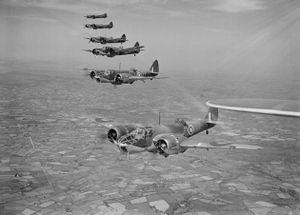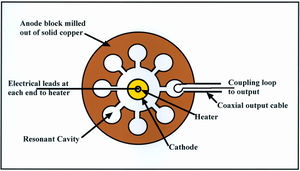Radio Location Takes to the Air - Chapter 3 of Radar and the Fighter Directors
By David L. Boslaugh, Capt USN, Retired
First Kill by Airborne Radio location
As previously mentioned, there was concern in the Air Ministry that if Chain Home were successful in stopping daylight bombings, the enemy would most likely resort to night bombing, and this would call for specially equipped night fighters. Even if CH and CHL could coach a night fighter to the general vicinity of an attacker, the fighter would need some form of radio location to help him home in on the bomber. The airborne RDF equipment would have to be compact and light, and the fighter’s antenna would have to be much smaller than any CH or CHL antenna. Engineer Dr. E. G. Bowen of the Bawdsey research team was assigned the job of developing an airborne RDF set, and the obvious place to start was the Army’s 1.5 meter coastal artillery fire control RDF. In the summer of 1936 he installed a 1.5 meter receiver in a test aircraft; but without a transmitter. His idea was to use a powerful ground based 1.5m transmitter and flood a target airplane with radio waves. The waves bounced off the target were indeed detected by the airborne receiver at ranges up to twelve miles. Bowen urged Watson-Watt to put the system into production, but Watson-Watt would have none of it. [22, p.246]
Bowen set off to design an airborne 1.5 meter set complete with transmitter and receiver, and by 1937 he had a set capable of transmitting 100 watts. Range could be measured with an A-scope, and crude bearing and elevation determination was done by placing dipole antennas on the airplane’s wing tips. If the target was off to one side the return from that side was larger than the opposite antenna so the RDF operator could tell the pilot to turn until the two signals were of the same height. A similar scheme with dipoles above and below the wings facilitated elevation measurement. The system, called RDF 2, had some drawbacks, however. First, was maximum range. Radio emissions at 1.5 meters could not be focused into a narrow beam with the small airborne antenna, instead they went out in a spherical wavefront with the result that the receiver would pick up an echo from the ground that blanked out any target at a range greater than the plane’s altitude. At best, the Chain Home system could bring an interceptor to within about three miles from a target, which meant that RDF 2 was not very effective at altitudes below 16,000 feet. Next, the outgoing transmitter pulse was about 1,000 feet long and it saturated the receiver out to this distance so that targets were lost when the interceptor got within 1,000 feet of the target. RAF rules required absolute visual verification that a target was an enemy before firing, so the pilot had to get a good sighting in the dark at distances beyond 1,000 feet. [22, pp.246-247]
In spite of RDF 2’s drawbacks, on 1 August 1939 Bowen got surprise orders to not only manufacture thirty RDF 2 sets by months end, but also install them in thirty Bristol Blenheim twin-engine light bombers by that time. They were to be converted to night fighters with four machine guns mounted under the fuselage. When the appointed time came, Bowen’s team of twenty had sets installed in six of the planes. War broke out three days later, and these six immediately began night patrols over London. The official designation of the sets was changed from RDF 2 to AI (Airborne Interception) Mark II, and Bowen’s original prototype RDF 2 was designated AI Mark I. By October 1939 Bowen had made enough improvements that his next model was designated AI Mark III. [22, pp.251-252]

It was a clear night with a full moon near midnight on 22 July 1940, and the Poling CH station had just picked up an incoming blip. An airborne Blenheim night fighter under the command of Flying Officer G. Ashfield was vectored toward the raider, and ground control was turned over to Tangmere, the Blenheim’s home base. There, Wing Commander Chamberlain assumed control. His task was to bring the interceptor around in a circle so that it would end up on the raider’s tail, and above it so Ashfield could get a view of moonlight reflecting off the target. As the Blenheim slowly gained on their prey, Sergeant R. H. Leyland operating the AI Mark III saw a blip on his scope and began coaching Flying Officer Ashfield into firing position. As the range closed to 1,000 feet the observer stationed in the nose glimpsed a dark shape above them, but then the blip disappeared, as predicted, and the shape vanished. They were coming in too low, so Ashfield pulled the nose up to see the shape again. It was a Dornier 17, and fair game. He fired two bursts and the Dornier turned into ball of fire and flying parts. It was the first successful RDF guided night fighter intercept in the Battle of Britain. [22, pp.252-255]
The Cavity Magnetron
The AI Mark III emitted just enough power to make it barely workable. If airborne RDF was really going to work, a valve capable of much more power and higher frequencies than that used in the Mark III was needed. Radio waves with wavelengths measured in centimeters rather than meters were called for so that small airborne antennas could focus the waves into narrow beams. That way, bearing and elevation measurements could be much more precise, and there would be no more target-obscuring ground return. By early 1939 just about every person associated with British RDF development agreed that a completely new approach to valves was needed. The first step was to bring knowledgeable engineers and scientists together in a new committee: the Inter-Services Committee for the Coordination of Valve Development, to be chaired by Frederick Brundrett, principal scientific officer of the Royal Naval Scientific Service in London.
After a review of industry and academic laboratories that might be capable of taking on the new valve development task, Brundrett zeroed in on Professor Mark Oliphant, head of the physics department at the University of Birmingham. He had impressed Brundrett and Tizard with some of his previous work. As a first action, in the summer of 1939, Oliphant and some of his staff visited every activity working on radio location so they could get a feel for valve state of the art and what was needed. Upon their return in September, Oliphant broke his staff into a number of two-man teams, each to pursue their own approach. Professor John Randall and his graduate student assistant, Henry Boot, formed one of the teams. After a couple of fruitless approaches, they reverted back to surveying scientific literature to see if there were possibly some other ideas that might work, when a paper on rotating magnetic field theory caught their imagination. The paper described a device called a magnetron. [22, p.22]
The magnetron was invented by General Electric engineer Albert W. Hull in 1916 when he sought an alternative to the conventional vacuum tube triode - which had a heated filament, a “plate” element and a control “grid”. In operation, a direct current voltage applied between the filament and the plate caused electrons to flow from the incandescent filament to the plate, and a current flowed around the circuit. The grid was placed between the filament and the plate, and a voltage applied to the grid could control the number of electrons, or current, flowing in the plate circuit. A relatively small signal change applied to the grid caused a larger change in plate current in direct proportion to the signal change. In the magnetron, Hull used a varying magnetic field in place of the grid, to control the current in the plate circuit. When a beam of electrons pass through a magnetic field, the beam is turned in a spiral and the beam would be deflected away from the plate in an amount proportional to magnetic field strength. Hull also wrote that he had some problems with the magnetron. At some combinations of magnetic field strength and plate voltages, the tube broke in to undesired oscillations, and these oscillations were at centimeter wavelengths. Thus to Randall and Boot, here was another way to generate radio waves at microwave frequencies, albeit at relatively low power.
The two investigators next read of another device called a klystron recently invented by the brothers R.H. and S.F. Varian. This vacuum tube (valve) was made out of a solid block of metal, with a small cavity hollowed out of it. They had found that if a beam of electrons were passed over the opening of the cavity, electrons in the cavity would resonate at microwave frequencies. This is similar to blowing air over the mouth of a jug to make the air in the jug resonate and produce a sound. Again, the amount of microwave power that could be extracted by a probe in the cavity was small, about ten watts. Randall and Boot decided to combine the principles of the magnetron and the klystron. In their device there would be eight cavities cut into the periphery of a hole drilled through a block of copper. There would be an incandescent filament running through the axis of the hole and there would be a strong direct current voltage applied between the filament and the copper block. To make the electrons from the filament flow across the mouth of the eight cavities as they traveled at high speed toward the periphery of the hole, the inventors impressed a strong magnetic field in parallel with the filament. This made the electrons spiral past the cavities. A probe inserted in one of the cavities would draw off the hoped for microwave power. [6, p.30]
On 21 February 1940 Randall and Boot sealed the sides of the copper block and pumped the inside down to a vacuum. They put the block between the poles of a strong permanent magnet and connected a pulsing direct current power supply between the copper block anode and the central cathode. In the output circuit connected between the probe and the cathode they wired a pair of headlights taken from a car in the parking lot. They were hoping for enough power to make the lights glow. They applied the pulsed power and the lights glowed all right. In fact they flashed and blew out. Next came a larger pair of headlights from a truck, and they blew too. After sacrificing a series of increasingly large headlights, they connected some neon floodlights that could sustain the power. They found their “cavity magnetron” was producing 100 kW peak power in the pulses and 400 watts average power. The wavelength was just about ten centimeters. The two had created the holy grail of airborne radio location. Within days of their triumph, the Telecommunications Research Establishment began a crash program to build an airborne intercept radar based on the cavity magnetron. One wonders if the owners of the vehicles with the borrowed headlights knew of the missing parts when they started for home that night. [22, p.250] [43, p.199] [40, p.414]
Click here to go to "Birth of Radio Location in the United States Navy - Chapter 4 of Radar and the Fighter Directors"
